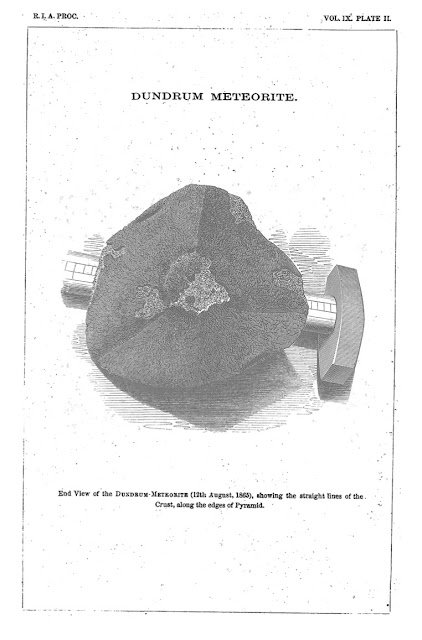The Stone of Cashel
In The Book of the Damned, Fort introduced us to The Stone of Cashel, an unusually shaped and strangely marked stone that had fallen out of the sky in Dundrum, near Cashel, in County Tipperary. And as a way to celebrate the upcoming anniversary of the publication of Fort’s first collection of oddities and anomalies, I thought I’d post some additional material from Fort’s source for this story, the Proceedings of the Royal Irish Academy.
“I, John Johnson, of the parish of Clonoulty, near Cashel, county Tipperary, was walking across my potato garden, at the back of my house, in company with Michael Fahy and William Furlong, on the 12th of August, 1865, at seven P. M., when I heard a clap, like the shot out of a cannon, very quick, and nutlike thunder; this was followed by a buzzing noise, which continued for about a quarter of an hour, when it came over our heads; and on looking up, we saw an object falling down in a slanting direction. We were frightened at its speed, which was so great that we could scarcely notice it; but after it fell, we proceeded to look for it, and found it at a distance of forty yards, half buried in the ground, where it had struck the top of a potato drill. We were some time in looking for it (a longer time than that during which we had heard the noise). On taking up the stone, we found it warm, milk warm, but not hot enough to be inconvenient. The next day it was given up to Lord Hawarden.”
A description of the stone, prepared by Dr. Haughton, appeared in the same issue:
“The stone weighed 4lbs. 14 ½ oz. It is rudely pyramidal in form; the triangular base being a freshly broken surface, and the faces of the pyramid being covered by the usual black vitrified glaze. It is evidently a portion of a much larger stone; and as it appears from the foregoing statement that its vertical velocity was not great, it is probable that other pieces of the larger mass may yet be found in the neighbourhood of Dundrum.
“A singular feature is observable in this stone that I have never yet seen in any other:- the rounded edges of the pyramid are sharply marked by lines on the black crust, as perfect as if made by a ruler. This appearance is strictly confined to the surface, and seems to be a result of some peculiar tension of the fused crust in cooling; for no trace of any continuation of the lines can be found in the interior of the stone.”
And this is what Fort had to say about Haughton’s interpretation of the markings:
“Dr Haughton’s idea is that the marks may have been made by some ‘peculiar tension in the cooling.’ It must have been very peculiar, if in all aerolites not wedge-shaped, no such phenomenon had ever been observed. It merges away with one or two instances known, after Dr. Haughton’s time, of seeming stratification in meteorites. Stratification in meteorites, however, is denied by the faithful.
“I begin to suspect something else.
“A whopper is coming.
“Later, it will be as reasonable, by familiarity, as anything else ever said.
“If someone should study the stone of Cashel, as Champollion studied the Rosetta stone, he might — or, rather, would inevitably — find meaning in those lines, and translate them into English—"
Source:
Haughton, Samuel, and John Johnson. “On the Meteoric Stone That Fell at Dundrum, County of Tipperary, on the 12th August, 1865.” Proceedings of the Royal Irish Academy (1836-1869), vol. 9, 1864, pp. 336–343.


Comments
Post a Comment